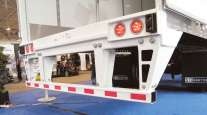Underride Guards Are Improved, But More Work Needed, Study Says
This story appears in the March. 18 print edition of Transport Topics.
A new round of underride guard tests released last week by an insurance group showed trailer makers have made progress in protecting auto passengers during rear-end crashes, but the group said more needs to be done to enhance safety.
The Insurance Institute for Highway Safety, based in Arlington, Va., performed three different tests on trailers from eight manufacturers. Every manufacturer’s equipment passed the test when a car crashed directly into the underride guard, and all but one passed when 50% of the car’s width hit the trailer. However, all but one trailer failed the test when only 30% of the car overlapped with the trailer.
“Modern semitrailers, for the most part, do a good job of keeping passenger vehicles from sliding underneath them,” the report said. “But in crashes involving only a small portion of the truck’s rear, most trailers fail to prevent potentially deadly underride.”
The March 14 announcement came two years after a smaller round of tests that prompted IIHS to declare that the guards were inadequate and to ask the National Highway Traffic Safety Administration for tougher standards. The federal agency, which sets new equipment safety standards, still hasn’t responded to that petition.
IIHS Chief Research Officer David Zuby told Transport Topics the results indicated progress, even though the 2011 and 2013 tests were difficult to compare because just three trailers were used in the initial round.
Federal underride rules, which have not been revised since 1998, exclude some equipment such as dump trucks. NHTSA’s 2011 data show underride accidents killed 260 people, or about 12% of car occupants who die in truck crashes. Those fatalities have fallen 43% since 2004, in line with improved truck highway safety.
NHTSA Administrator David Strickland told TT the agency is studying possible changes and that agency officials have met with insurer and industry representatives about the issue.
Trailers made by Great Dane, Hyundai Translead, Manac, Stoughton, Strick, Utility, Vanguard and Wabash National passed the direct impact test in which 100% of the car’s hood hit the underride guard. All but Vanguard’s trailers were given a passing grade on the 50% overlap test. Only Manac’s unit passed the 30% test.
In the earlier tests, IIHS didn’t give pass or fail grades.
TT contacted all the manufacturers. Four commented by press time.
“Stoughton performed among the best in underride protection,” said Stoughton Vice President of Sales and Marketing David Giesen. “This reinforces our priority to provide a safe, well-designed, durable trailer. Limiting accident severity from rear underride is important to our customers.”
Charles Dutil, president of Manac, said the test results “prove the point that we have been making for the last few years. There is more than the up-front cost in buying a trailer.”
The ability to repair the trailer is a huge factor, Dutil said, noting that some others’ trailers were heavily damaged in the tests.
“Great Dane Trailers is pleased that the recent Insurance Institute for Highway Safety tests have demonstrated that rear impact guards installed on Great Dane trailers performed well in preventing underride,” Vice President Brandie Fuller said. “Great Dane Trailers joins the Truck Trailer Manufacturers Association in supporting research initiatives that seek effective ways to reduce injuries and deaths.”
“All of our trailers are built to comply with Canadian and U.S. requirements,” said Vanguard President Charles Mudd. “They have passed all tests to show they do comply.”
The TTMD said it welcomed research into improving the safety of underride guards. But the group criticized IIHS for recommending that guards be generally more rigid and not proposing specific new standards.
American Trucking Associations recognized the role of underride guards in mitigating the effects of some crashes, but spokesman Sean McNally said it is also important to prevent such crashes in the first place.
“More driver education on sharing the road with large commercial vehicles is a must, and promoting greater use of collision-avoidance technology in both cars and trucks will also produce results,” McNally said.
In the tests, when 30% and 50% of the car’s width hit the trailer, the car’s left front hit the right side of the trailer as if the auto was passing the truck on the right. No test was done as if the car was passing the truck on the left.
The 30% overlap test is the minimum overlap that could result in a driver being hurt in an underride crash, the report said.
A 2010 Chevrolet Malibu, which earned IIHS’ “Top Safety Pick” designation, was used for the tests. IIHS members write 80% of auto policies.
The Malibu, occupied only by a dummy in the driver’s seat, hit stationary trailers at 35 mph.
The insurance group said only Manac trailers have underride guards with vertical supports that are 18 inches from the trailer’s edge and attached to the floor. The others’ guards are 28 inches from the edge and are attached to slider rails, making them more brittle, IIHS said.
Manac’s approach costs about $20 and adds 20 pounds to trailer weight while reducing intrusion, IIHS estimated.


